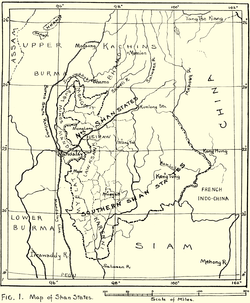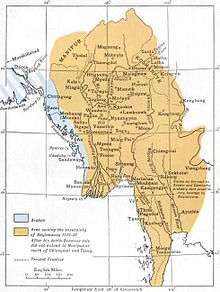Shan States
The Shan States (1885–1948) were a collection of minor Shan kingdoms called muang whose rulers bore the title saopha in British Burma. They were analogous to the princely states of British India.
Shan States British Shan States | |||||||||||
|---|---|---|---|---|---|---|---|---|---|---|---|
| 1215–1885 1885–1948 1948–1959 | |||||||||||
 1917 map of the British Shan States | |||||||||||
| Status | Princely state (1215–1885; 1948–1959) British Protectorate (1885–1948) | ||||||||||
| Capital | Mogaung | ||||||||||
| Common languages | Shan, Burmese | ||||||||||
| Religion | Theravada Buddhism, animism | ||||||||||
| Government | Monarchy | ||||||||||
| |||||||||||
| History of Myanmar |
|---|
 |
|
|
|
|
The term "Shan States" was first used during the British rule in Burma as a geopolitical designation for certain areas of Burma (officially, the Federated Shan States, which included the Karenni States, consisted of today's Shan State and Kayah State). In some cases, the Siamese Shan States was used to refer to Lan Na (northern Thailand) and Chinese Shan States to the Shan regions in southern Yunnan such as Xishuangbanna.
Historical mention of the Shan states inside the present-day boundaries of Burma began during the period of the Pagan Dynasty; the first major Shan State of that era was founded in 1215 at Mogaung, followed by Mone in 1223. These were part of the larger Tai migration that founded the Ahom Kingdom in 1229 and the Sukhothai Kingdom in 1253.[1] Shan political power increased after the Mongols overran Pagan in 1287 and the Shans came to dominate many of the northern to eastern areas of Burma—from northwestern Sagaing Division to the present-day Shan Hills. The newly founded Shan States were multi-ethnic states that included a substantial number of other ethnic minorities such as the Chin, Palaung, Lisu, Pa-O, Kachin, Wa, and Burmans.
The Shan States were a dominant force in the politics of Upper Burma throughout the 13th to 16th centuries. The strongest Shan States, Mogaung, Mongyang and Hsenwi, constantly raided Upper Burma. Mogaung ended the kingdoms of Sagaing and Pinya in 1364. The Mohnyin-led Confederation of Shan States captured the Ava Kingdom in 1527 and ruled Upper Burma until 1555.
The Shan States were too fragmented to resist the encroachment of bigger neighbours. In the north, China annexed today's Yunnan in the 1380s, stamping out the final Shan resistance by the 1440s. In the south, the Toungoo Dynasty captured all those Shan States that would become known as Burmese Shan States in 1557. Though the Shan States came under the suzerainty of Burmese kingdoms based in the valley of the Irrawaddy River, the Shan saophas (chiefs) retained a large degree of autonomy.
When Burma gained independence in 1948, the Federated Shan States became Shan State and Kayah State of the Union of Burma with the right to secede from the Union. However, the Shan States and the saophas' hereditary rights were removed by Gen. Ne Win's military government in 1962.
Historical states
Most Shan States were just little principalities organised around the chief town in the region. They played a precarious game of paying allegiance to more powerful states, sometimes simultaneously. Smaller states such as Loi-ai, Monghsat and Monghsu paid allegiance to more powerful Shan states like Yawnghwe, Kengtung and Hsenwi. The larger Shan States in turn paid tribute to larger neighbours such as the Ava, the Burmese Kingdom and China.
Some of the major Shan States were.[2]
History
Early history of the Shan states is clouded in myth. Most states claimed having been founded upon a predecessor state with a Sanskrit name. Tai Yai chronicles usually begin with the story of two brothers, Khun Lung and Khun Lai, who descended from heaven in the 6th century and landed in Hsenwi, where the local population hailed them as kings.[3]
The Shan people have inhabited the Shan Highlands and other parts of northern modern-day Burma as far back as the 10th century AD. The Shan kingdom of Mong Mao (Muang Mao) existed as early as the 10th century CE but became a Burmese vassal state during the reign of King Anawrahta of Pagan (1044–1077).[4]
Pagan Dynasty period
The historical relevance of the Shan states inside the present-day boundaries of Burma increased during the period of the Pagan Kingdom in the Shan Hills and Kachin Hills and accelerated after the fall of the Pagan Kingdom to the Mongols in 1287. The Shans, including a new migration that came down with the Mongols, quickly came to dominate an area from northern Chin State and northwestern Sagaing Region to the present-day Shan Hills. The newly founded Shan States were multi-ethnic states that included a substantial number of other ethnic minorities like the Chin, Palaung, Pa-O, Kachin, Akha, Lahu, Wa and Burmans. The most powerful Shan states were Mohnyin (Mong Yang) and Mogaung (Mong Kawng) in present-day Kachin State, followed by Theinni (Hsenwi), Thibaw (Hsipaw), Momeik (Mong Mit) and Kyaingtong (Keng Tung) in present-day northern Shan State.[5]
Confederation of Shan States
The Confederation of Shan States were a group of Shan States that conquered the Ava Kingdom in 1527 and ruled Upper Burma until 1555. The Confederation originally consisted of Mohnyin, Mogaung, Bhamo, Momeik, and Kale. It was led by Sawlon, the chief of Mohnyin. The Confederation raided Upper Burma throughout the early 16th century (1502–1527) and fought a series of war against Ava and its ally Shan State of Thibaw (Hsipaw). The Confederation finally defeated Ava in 1527, and placed Sawlon's eldest son Thohanbwa on the Ava throne. Thibaw and its tributaries Nyaungshwe and Mobye also came over to the confederation.
The enlarged Confederation extended its authority down to Prome (Pyay) in 1533 by defeating their erstwhile ally Prome Kingdom because Sawlon felt that Prome did not provide sufficient help in their war against Ava. After the Prome war, Sawlon was assassinated by his own ministers, creating a leadership vacuum. Although Sawlon's son Thohanbwa naturally tried to assume the leadership of the Confederation, he was never fully acknowledged as the first among equals by other saophas.
An incoherent confederation neglected to intervene in the first four years of Toungoo–Hanthawaddy War (1535–1541) in Lower Burma. They did not appreciate the gravity of the situation until 1539 when Toungoo defeated Hanthawaddy, and turned against its vassal Prome. The saophas finally banded together and sent in a force to relieve Prome in 1539. However, the combined force was unsuccessful in holding Prome against another Toungoo attack in 1542.
In 1543, the Burmese ministers assassinated Thohanbwa and placed Hkonmaing, the saopha of Thibaw, on the Ava throne. Mohnyin leaders, led by Sithu Kyawhtin, felt that the Ava throne was theirs. But in light of the Toungoo threat, Mohnyin leaders grudgingly agreed to Hkonmaing's leadership. The Confederation launched a major invasion of Lower Burma in 1543 but its forces were driven back. By 1544, Toungoo forces had occupied up to Pagan. The confederation would not attempt another invasion. After Hkonmaing died in 1546, his son Mobye Narapati, the saopha of Mobye, became king of Ava. The confederation's bickering resumed in full force. Sithu Kyawhtin set up a rival fiefdom in Sagaing across the river from Ava and finally drove out Mobye Narapati in 1552.
The weakened Confederation proved no match for Bayinnaung's Toungoo forces. Bayinnaung captured Ava in 1555 and conquered all of Shan States in a series of military campaigns from 1556 to 1557.
British rule in Burma
_at_the_Durbar%2C_Delhi%2C_India.jpg)
In 1885, following three wars that steadily added various parts of Burma to their empire, the British finally occupied all of the territory of present-day Myanmar. The area became then a Province of British India.[6]
Under the British colonial administration, the Shan States became nominally sovereign princely states. Although states were ruled by local monarchs, they were subject to a subsidiary alliance under the paramountcy of the British Crown.[7][8]
Towards the last phase of British rule the Shan and Karenni states were labeled as "Frontier Areas", a broad designation for mountainous areas bordering India, China and Laos where the British government allowed local rule. in 1922 the Shan states were joined together into a Federation, the Federated Shan States. They were administered separately by the Burma Frontier Service by British Assistance Superintendents, later renamed as Assistant Residents.[9]
In 1935 the Frontier Areas were divided into "Excluded Areas" and "Partially Excluded Areas" —also known as "Part I Areas" and "Part II Areas"— through the Government of Burma Act.[10]
Chinese Shan States

.jpg)
The Chinese Shan States were petty states or small territories of Shan people ruled by local monarchs under the suzerainty of China. They were also known as Koshanpye or "Nine Shan States". The main states were Mönglem (Mainglengyi, Maing-ying, Mienning, Mong Lien), Möngmāu (Mong Mao), Hsikwan (Si-gwin), Möngnā (Mong Na and its three dependent states of Mong Hsung, Mong Kaw and Mong Tum), Sandā (Zhanda, Mong-Santa), Hosā (Ho Hsa, Hotha), Lasā (Mong Hsa, La Hsa), Möngwan (Mong Wan, Mo-wun), Möngmyen (Mong Myen, Momien, Momein/Tengyue) and Köng-ma (Küngma, Kaing-ma, Kengma, Gengma),[11] among others, in addition to Keng Hung (Chiang Hung).[12]
Most of the history of these petty Tai (Dai) Kingdoms is obscure. Existing chronicles and traditions regarding the northernmost outlying Shan States include conflicting names and dates which have led to different interpretations.[13] According to ancient tradition there was a State of Pong that had its origin in the legendary kingdom of Udiri Pale, founded in 58 BC. The Cheitharol Kumbaba Manipuri Kingdom chronicle —written much later— mentions an alliance between the Kangleipak State and the Kingdom of Pong.[14] This quasi-legendary kingdom is also mentioned among the conquests of Anoratha, the King of Pagan. Some scholars identify the Kingdom of Pong with Mong Mao as well as with the kingdom of Luh Shwan mentioned in Chinese chronicles.[13]
Vassal states to more powerful kingdoms in China, these Shan States gained a measure of independence in the power vacuum left after the Kingdom of Dali in Yunnan fell to the Mongol Yuan Dynasty.[15] By the 17th century the territories of these outlying Shan States had been merged into Chinese dynasties, their rulers being allowed to retain a great measure of authority under the Tǔsī Zhìdù (Chinese: 土司制度) system of recognized chieftainship.[16] In mid 18th century, the Konbaung Dynasty's armies led a series of wars against the Chinese Qing Dynasty following which eight of the Chinese Shan states were briefly occupied by the Kingdom of Burma, but all of these northernmost Shan States remained under Chinese rule after that.[9]
The former Chinese Shan States are now part of Yunnan Province. Under the Chinese administration the status of the Shan people in the Chinese Shan States was reduced when they were labelled as a "minority". Thus they became one more among the other ethnic minorities in that area of present-day Yunnan such as the Lahu and the Va.[17]
See also
- List of Shan states and rulers
- Shan people
- Wa States
Bibliography
- C. Patterson Giersch, Asian Borderlands: The Transformation of Qing China's Yunnan Frontier. Harvard University Press (2006), ISBN 9780674021716
References
- Maung Htin Aung (1967). A History of Burma. New York and London: Cambridge University Press. p. 66.
- Shan and Karenni States of Burma
- Historical Studies of the Tai Yai: A Brief Sketch in Lak Chang: A Reconstruction of Tai Identity in Daikong by Yos Santasombat
- Nisbet, John. Burma under British Rule - and before. Volume 2. Adamant Media Corporation. p. 414. ISBN 1-4021-5293-0.
- Jon Fernquest (Autumn 2005). "Min-gyi-nyo, the Shan Invasions of Ava (1524–27), and the Beginnings of Expansionary Warfare in Toungoo Burma: 1486–1539". SOAS Bulletin of Burma Research, Vol. 3, No. 2. ISSN 1479-8484.
- Encyclopædia Britannica
- Great Britain India Office. The Imperial Gazetteer of India. Oxford: Clarendon Press, 1908.
- Census of India 1901 - Burma
- Kanbawsa - A Modern Review
- Donald M. Seekins, Historical Dictionary of Burma (Myanmar), p. 193
- Kaung: Miex, Kaung: Max [Gaeng Miex, Gaeng Max] N23.33, Е99.25. Town in Yunnan, Gengma County town. 'Mother's fields'. Other names: Gengma, Küngma, Kaingma, 耿马 Gěngmǎ; Dictionary of Wa (2 vols): With Translations into English, Burmese and Chinese By Justin Watkins, p. 1139
- Peter Truhart, Asia & Pacific Oceania, p. 218
- Yos Santasombat, Lak Chang: A Reconstruction of Tai Identity in Daikong, p. 3-4
- Phanjoubam Tarapot, Bleeding Manipur, Har Anand Publications (July 30, 2007) ISBN 978-8124109021
- Daniels, Christian (2006) "Historical memories of a Chinese adventurer in a Tay chronicle; Usurpation of the throne of a Tay polity in Yunnan, 1573–1584," International Journal of Asian Studies, 3, 1 (2006), pp. 21–48.
- John Anderson. Mandalay to Momien : a narrative of the two expeditions to western China of 1868 and 1875 under Colonel Edward B. Sladen and Colonel Horace Browne (2009)
- Susan Conway, The Politics of Inland Southeast Asia, SOAS
External links

- "Gazetteer of Upper Burma and the Shan states"